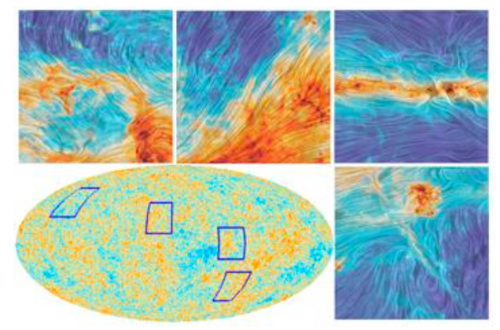New revelations on dark matter and relic neutrinos

The Planck collaboration, which notably includes the CNRS, CEA, CNES and several French universities, has disclosed, at a conference in Ferrara, Italy, the results of four years of observations from the ESA's Planck satellite. The satellite aims to study relic radiation (the most ancient light in the Universe). This light has been measured precisely across the entire sky for the first time, in both intensity and polarisation, thereby producing the oldest image of the Universe. This primordial light lets us "see" some of the most elusive particles in the Universe: dark matter and relic neutrinos.
Between 2009 and 2013, the Planck satellite observed relic radiation, sometimes called cosmic microwave background (CMB) radiation. Today, with a full analysis of the data, the quality of the map is now such that the imprints left by dark matter and relic neutrinos are clearly visible.
Already in 2013, the map for variations in light intensity was released, showing where matter was in the sky 380,000 years after the Big Bang. Thanks to the measurement of the polarisation of this light (in four of seven frequencies, for the moment), Planck can now see how this material used to move. Our vision of the primordial Universe has thus become dynamic. This new dimension, and the quality of the data, allows us to test numerous aspects of the standard model of cosmology. In particular, they illuminate the most elusive of particles: dark matter and neutrinos.
New constraints on dark matter
The Planck collaboration results now make it possible to rule out an entire class of models of dark matter, in which dark matter-antimatter annihilation is important. Annihilation is the process whereby a particle and its antiparticle jointly disappear, followed by a release in energy.
The basic existence of dark matter is becoming firmly established, but the nature of dark matter particles remains unknown. There are numerous hypotheses concerning the physical nature of this matter, and one of today's goals is to whittle down the possibilities, for instance by searching for the effects of this mysterious matter on ordinary matter and light. Observations made by Planck show that it is not necessary to appeal to the existence of strong dark matter-antimatter annihilation to explain the dynamics of the early universe. Such events would have produced enough energy to exert an influence on the evolution of the light-matter fluid in the early universe, especially around the time relic radiation was emitted. However, the most recent observations show no hints that this actually took place.
These new results are even more interesting when compared with measurements made by other instruments. The satellites Fermi and Pamela, as well as the AMS-02 experiment aboard the International Space Station, have all observed an excess of cosmic rays, which might be interpreted as a consequence of dark matter annihilation. Given the Planck observations, however, an alternative explanation for these AMS-02 or Fermi measurements—such as radiation from undetected pulsars—has to be considered, if one is to make the reasonable hypothesis that the properties of dark matter particles are stable over time.
Additionally, the Planck collaboration has confirmed that dark matter comprises a bit more than 26% of the Universe today (figure deriving from its 2013 analysis), and has made more accurate maps of the density of matter a few billion years after the Big Bang, thanks to measurements of temperature and B-mode polarisation.
Neutrinos from the earliest instants detected
The new results from the Planck collaboration also inform us about another type of very elusive particle, the neutrino. These "ghost" particles, abundantly produced in our Sun for example, can pass through our planet with almost no interaction, which makes them very difficult to detect. It is therefore not realistic to directly detect the first neutrinos, which were created within the first second after the Big Bang, and which have very little energy. However, for the first time, Planck has unambiguously detected the effect these relic neutrinos have on relic radiation maps.
The relic neutrinos detected by Planck were released about one second after the Big Bang, when the Universe was still opaque to light but already transparent to these particles, which can freely escape from environments that are opaque to photons, such as the Sun's core. 380,000 years later, when relic radiation was released, it bore the imprint of neutrinos because photons had gravitational interaction with these particles. Observing the oldest photons thus made it possible to confirm the properties of neutrinos.
Planck observations are consistent with the standard model of particle physics. They essentially exclude the existence of a fourth species of neutrinos, previously considered a possibility based on the final data from the WMAP satellite, the US predecessor of Planck. Finally, Planck makes it possible to set an upper limit to the sum of the mass of neutrinos, currently established at 0.23 eV (electron-volt).
The full data set for the mission, along with associated articles that will be submitted to the journal Astronomy & Astrophysics (A&A), will be available December 22 on the ESA web site.
Journal information: Astronomy & Astrophysics
Provided by CNRS




















